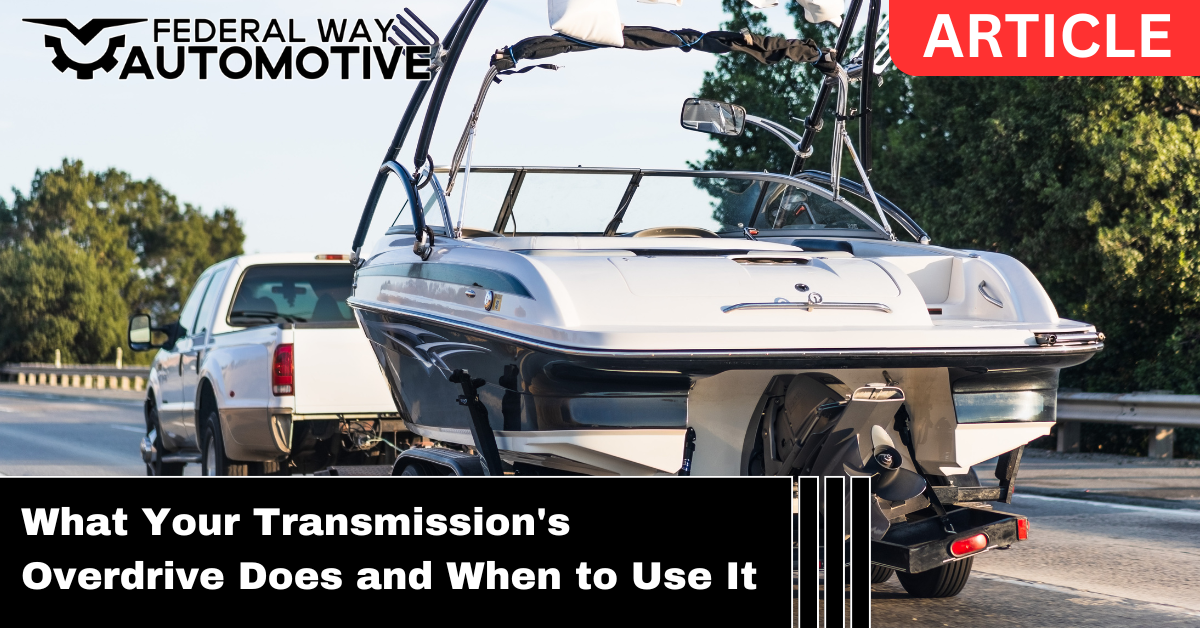If your vehicle has an overdrive button or setting, you’ve probably wondered what it does — and whether you should be using it while driving around town, towing, or cruising on the highway. Is it a fuel-saver? A performance mode? Something to leave alone?
At Federal Way Automotive, we regularly help drivers understand how their transmission works — and that includes how and when to use overdrive properly. Whether you’re trying to improve fuel economy, protect your transmission, or make smarter decisions while towing, here’s what you need to know.
What Is Overdrive?
Overdrive is the highest gear in your automatic transmission — typically the last gear in the sequence. It allows your engine to run at lower RPMs (revolutions per minute) while maintaining higher speeds, especially during freeway or highway driving.
This reduces engine strain, saves fuel, and helps extend the life of your transmission over time.
Think of it this way:
- Without overdrive: The engine works harder to maintain speed
- With overdrive: The engine turns more slowly, using less fuel to go the same speed
It’s not an extra gear in every case — in many modern vehicles, overdrive is just the top gear enabled when you’re not in “low” or “tow” mode.
When Should You Use Overdrive?
Use Overdrive for:
- Highway and freeway driving (typically above 45–50 mph)
- Long-distance travel on flat roads
- Daily commuting with steady speeds
- Maximizing fuel efficiency
Overdrive is your friend when it comes to cruising. It lowers engine RPM, which:
- Improves fuel economy
- Reduces engine wear
- Lowers cabin noise
- Keeps transmission temperatures in check
Avoid Overdrive for:
- Towing heavy loads
- Steep inclines or mountain roads
- Stop-and-go city traffic
- Descending long hills (you’ll want more engine braking)
When towing or climbing steep grades, your vehicle needs more torque and faster engine response. In those cases, overdrive can cause “gear hunting” — constantly shifting up and down — which puts added wear on your transmission and heats up the fluid faster.
That’s why many vehicles offer a way to turn overdrive off with a button on the gear selector or dashboard. If you’re pulling a trailer or driving through hilly terrain, turning off overdrive keeps the vehicle in lower gears and reduces transmission stress.
How Overdrive Affects Your Transmission
Using overdrive properly is good for your transmission, but using it in the wrong situations can lead to:
- Excessive shifting (up/down, also called gear hunting)
- Overheating the transmission fluid
- Premature clutch or band wear inside the transmission
If you’re driving with a heavy load or trailer, you may also notice reduced throttle response and sluggish performance when overdrive is engaged.
That’s why we recommend turning overdrive off during towing, then turning it back on once you’re back on level ground or highway cruising.
Do You Need to Turn Overdrive On or Off?
Most modern vehicles have overdrive on by default, and you only need to turn it off when needed — like during towing, climbing hills, or driving in mountainous areas.
If your vehicle has an “O/D Off” light on the dash, that means overdrive has been disabled. When the light is off, overdrive is engaged as normal.
So unless you’re towing or dealing with challenging terrain, leave overdrive on. It’s working in the background to keep your engine and transmission running more efficiently.
Transmission Maintenance and Overdrive Performance
If your vehicle seems to be struggling with shifting in or out of overdrive — or you notice hard shifts, slipping, or RPM spikes — it could be a sign that your transmission needs service.
A transmission flush or fluid exchange can help resolve symptoms like:
- Delayed shifts
- Harsh engagement when entering overdrive
- Overheating
- Gear slipping at highway speeds
Overdrive depends on proper fluid pressure and clean internal components. If the transmission fluid is old, burnt, or full of debris, performance can suffer.
Transmission Services in Federal Way, WA
At Federal Way Automotive, we help drivers get the most out of their vehicles — whether they’re towing through Tacoma or commuting across Federal Way. If you’re unsure about using overdrive, or your transmission isn’t shifting the way it used to, we’re here to help.
We offer:
- Full transmission diagnostics
- Professional transmission flush and fluid service
- Honest recommendations based on your vehicle’s age, mileage, and usage
Call us today or schedule your appointment online. Let’s keep your transmission working smoothly — and make sure overdrive is doing what it’s supposed to.


